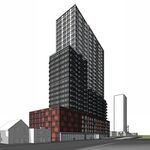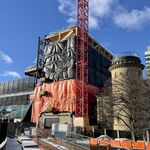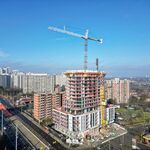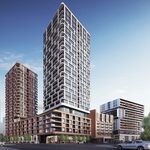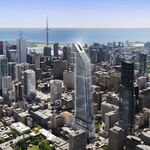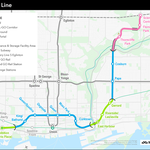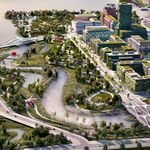No skyscraping development proposal on the desks of the planning office aims to eclipse it. Trying to would be almost sacrilegious in this city. The tallest freestanding structure in the Western Hemisphere, the CN Tower has become the quintessential icon of Toronto, looming large over Canada's largest urban area for 40 years. Opening on June 26, 1976 to much fanfare, the tower quickly gained status as a symbol of national pride. It put Toronto on the map and helped herald the city's transition from a puritanical provincial city into a cosmopolitan progressive metropolis. Yet the original plans for the tower, which today has become such an enduring landmark, painted a much different picture.
 Fireworks erupt from the CN Tower during the closing ceremonies of the 2015 Pan Am Games, image by Marcus Mitanis
Fireworks erupt from the CN Tower during the closing ceremonies of the 2015 Pan Am Games, image by Marcus Mitanis
When downtown railway freight yards were removed and replaced by newer facilities outside the core, nearly 200 acres of prime land became available for possible redevelopment. The surplus railway lands bounded by Bathurst, Yonge, the Gardiner Expressway and Front Street were owned by Canadian National and Canadian Pacific, who saw the area as a perfect candidate for a massive building complex. In 1967, planning studies for a modern mixed-use neighbourhood commenced. John Andrews, the Australian-born chair of the University of Toronto's school of architecture, collaborated with The Webb Zerafa Menkes Housden Partnership (now WZMH Architects) on the project. Their work was unveiled inside a Royal York Hotel ballroom on December 19, 1968 with a sprawling model that depicted the largest downtown redevelopment scheme in North American history.
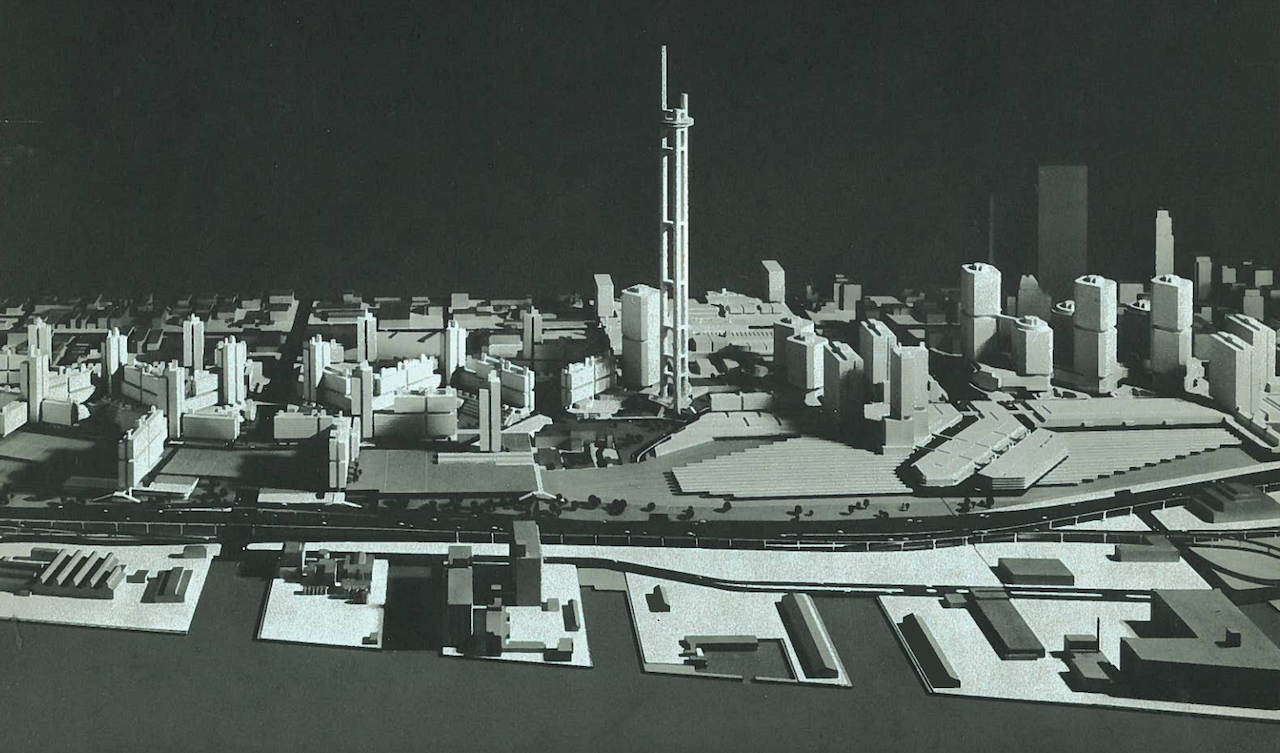 Metro Centre and the original tripod design of the CN Tower, image courtesy of WZMH and Idea Workshop
Metro Centre and the original tripod design of the CN Tower, image courtesy of WZMH and Idea Workshop
The Metro Centre plan called for 4.5 million square feet of office space, 600,000 square feet of commercial space and 9,300 residential units. Union Station would be demolished and its transportation services shifted to a new facility to be served by a south extension of the Yonge-University subway loop. Six octagonal office buildings with mid-air pedestrian connections would have taken its spot. A contemporary convention centre flanked by office buildings, one each for Canadian National and Canadian Pacific, was slated along with a southward extension of University Avenue. A significant residential component would be situated at the western end of the site, while the central area contained a communications area anchored by a new CBC English language headquarters and a 1,565-foot-high broadcasting tower.
Similar to what was ultimately included, the towering mast would have boasted a revolving restaurant and an observation deck. The design however was substantially different: the original plan envisioned a tripod of three cylindrical pillars connected by a series of structural bridges. Far surpassing the height of anything else in the city, it would have performed its duty as a broadcasting antenna, but it would not have unseated Moscow's Ostankino Tower as the world's tallest freestanding structure.
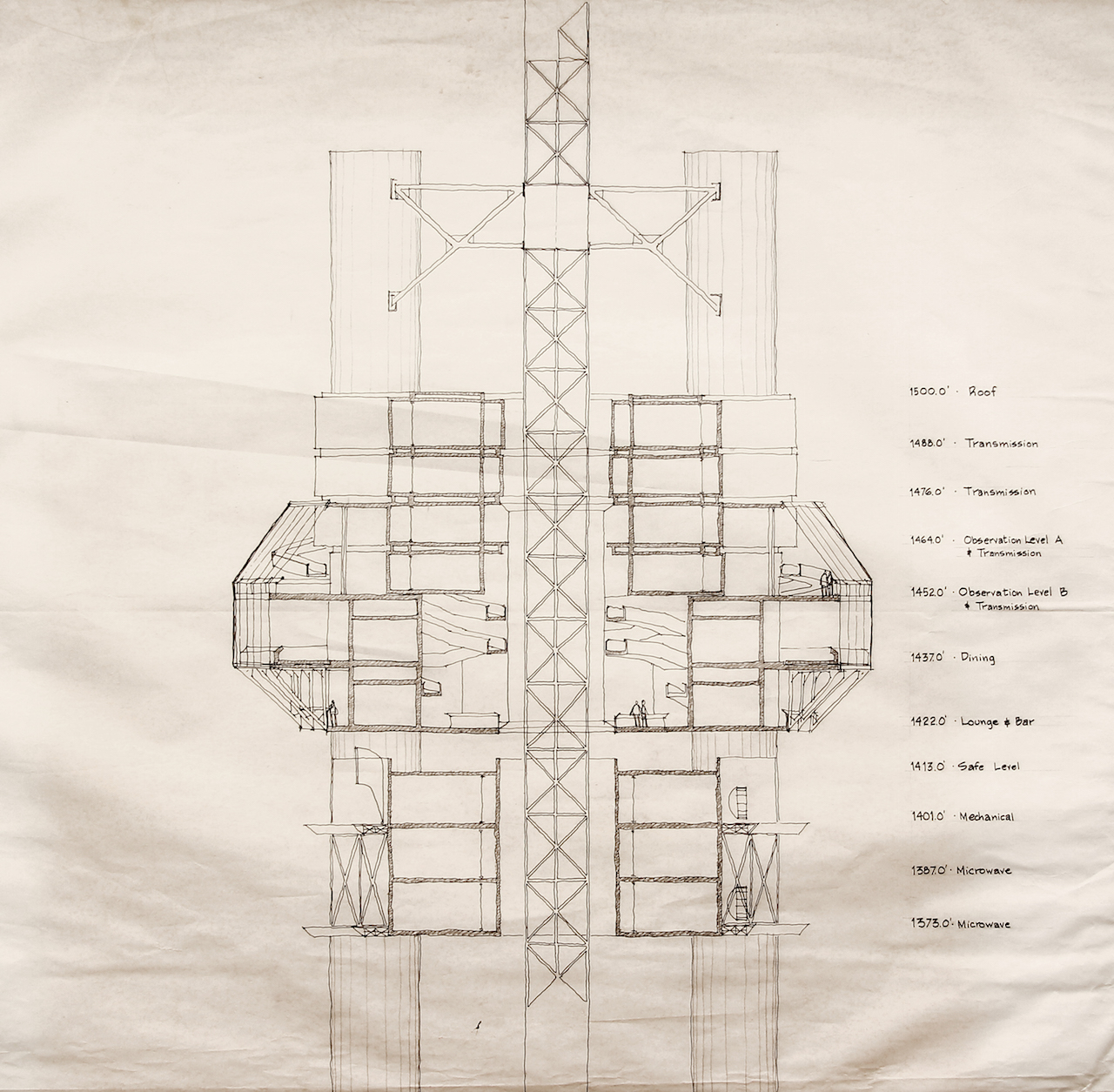 1969 sketch of the original tripod design, image courtesy of WZMH and Idea Workshop
1969 sketch of the original tripod design, image courtesy of WZMH and Idea Workshop
Subsequent years saw crucial elements of the plan discarded. Metro Toronto and the Toronto Transit Commission axed the idea of extending the subway loop to the south, while federal funding cuts to the CBC threatened its role in the development. As the project evolved, planning guidelines and official plan amendments were drafted and passed by council, and reaffirmed (with conditions) by the Ontario Municipal Board. Despite this, growing opposition to the demolition of Union Station, coupled with concern and fatigue of megaprojects—the Spadina Expressway had recently been cancelled—threatened to mothball the project entirely.
Construction on the tower commenced in 1973, but development agreements for the bulk of the complex had yet to be approved. By this time, the new council emerging from the elections of December 1972 proved to be decidedly less pro-development than the preceding batch of politicians. Metro Centre proponents put the plan on hold, a harbinger of the decision by premier Bill Davis in May 1975 to preserve and maintain Union Station as Toronto's central transportation hub. What was originally supposed to be a grand monument to the strength of Canadian industry had been declared dead, as the now isolated telecommunications tower, the only real remnant of the plan, rose into unchartered territory.
 Revised CN Tower design within the Metro Centre plan, image courtesy of WZMH and Idea Workshop
Revised CN Tower design within the Metro Centre plan, image courtesy of WZMH and Idea Workshop
And it rose with an entirely new design. Gone was the skeletal framework of vertical pipes and interconnecting bridges, deemed too difficult and expensive to build. The revised design fused the three pillars into a unified Y-shaped concrete shaft, while keeping the idea of an observation pod and restaurant. The proportions of the tower, which tapered as it grew in height, capitalized on the latest construction techniques available.
Patrick Quinn, co-founder of Toronto-based structural engineering firm Quinn Dressel, spearheaded the structural engineering practice at WZMH. Wanting to create a "Skidmore, Owings & Merrill" of the north, Quinn was instrumental in vetting the structural aspects of new projects, especially those like the CN Tower that pushed the engineering envelope. It was determined that the revised plan was indeed feasible, beginning the painstaking task of understanding how a practical construction process could be created. Human drafting, log tables and slide rules made the tower possible, as Franz Knoll, the tower's structural engineer, cooked a viable building recipe.
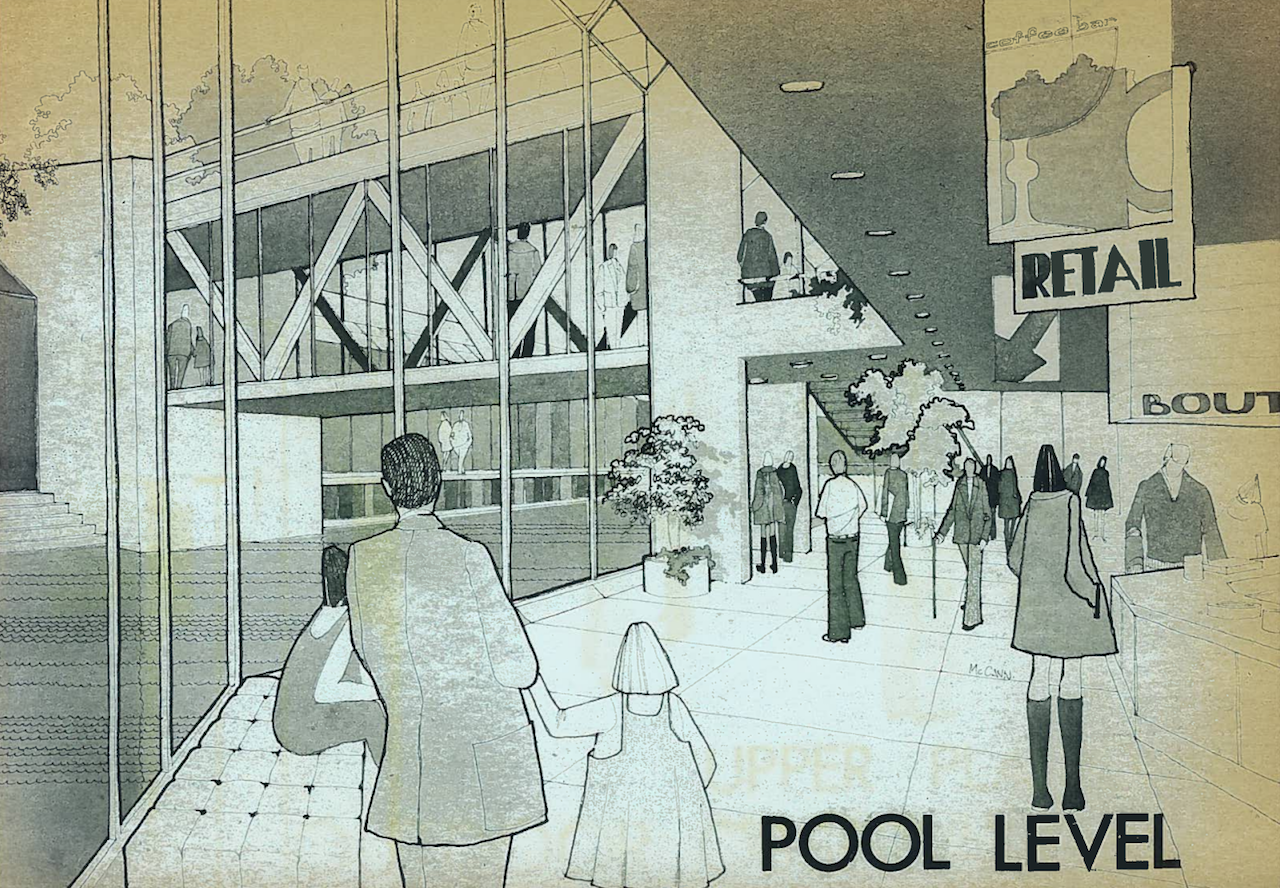 Drawing of the axed pool level, image courtesy of WZMH and Idea Workshop
Drawing of the axed pool level, image courtesy of WZMH and Idea Workshop
The design of the tower continued to evolve for practical and aesthetic reasons. Gone was the busy base of the tower, which was to feature a reflecting pool alongside terraces of restaurants and shops. The SkyPod, which would become the highest observation deck in the world, was added to the plan. So to was the white bubble radome below the outdoor observation level that serves to hide the microwave receivers. There was also the question of just how high the tower should go, coupled with the very real possibility that a world record could be broken. President and CEO of Canadian National Robert Bandeen, described by Quinn as a "visionary with artistic sense", pushed for a height surpassing that of the Ostankino Tower. His wish would be granted — the tower's final height measured 553.3 metres, trumping Moscow's landmark by 13 metres.
 The SkyPod was not part of the original design of the CN Tower, image by Marcus Mitanis
The SkyPod was not part of the original design of the CN Tower, image by Marcus Mitanis
Since no tower had climbed to such a pinnacle before, ingenious calculations and preparations had to be made. The working platform had to move upwards as construction progressed. Therefore, it needed the capability of being changed as the profile of the tower narrowed. This sliding form also had to be pulled up with hydraulics against concrete that was setting, necessitating the creation of a special concrete mix, one that was liquid enough to ensure the form did not get stuck. These prescient considerations ensured the tower's cutting-edge design was fulfilled without any major construction or engineering issues. "It's a sign of success when you've thought out the conditions in advance and you don't have to deal with any crisis in the construction phase," said Quinn, who described both the tower and Franz Knoll as ahead of their time.
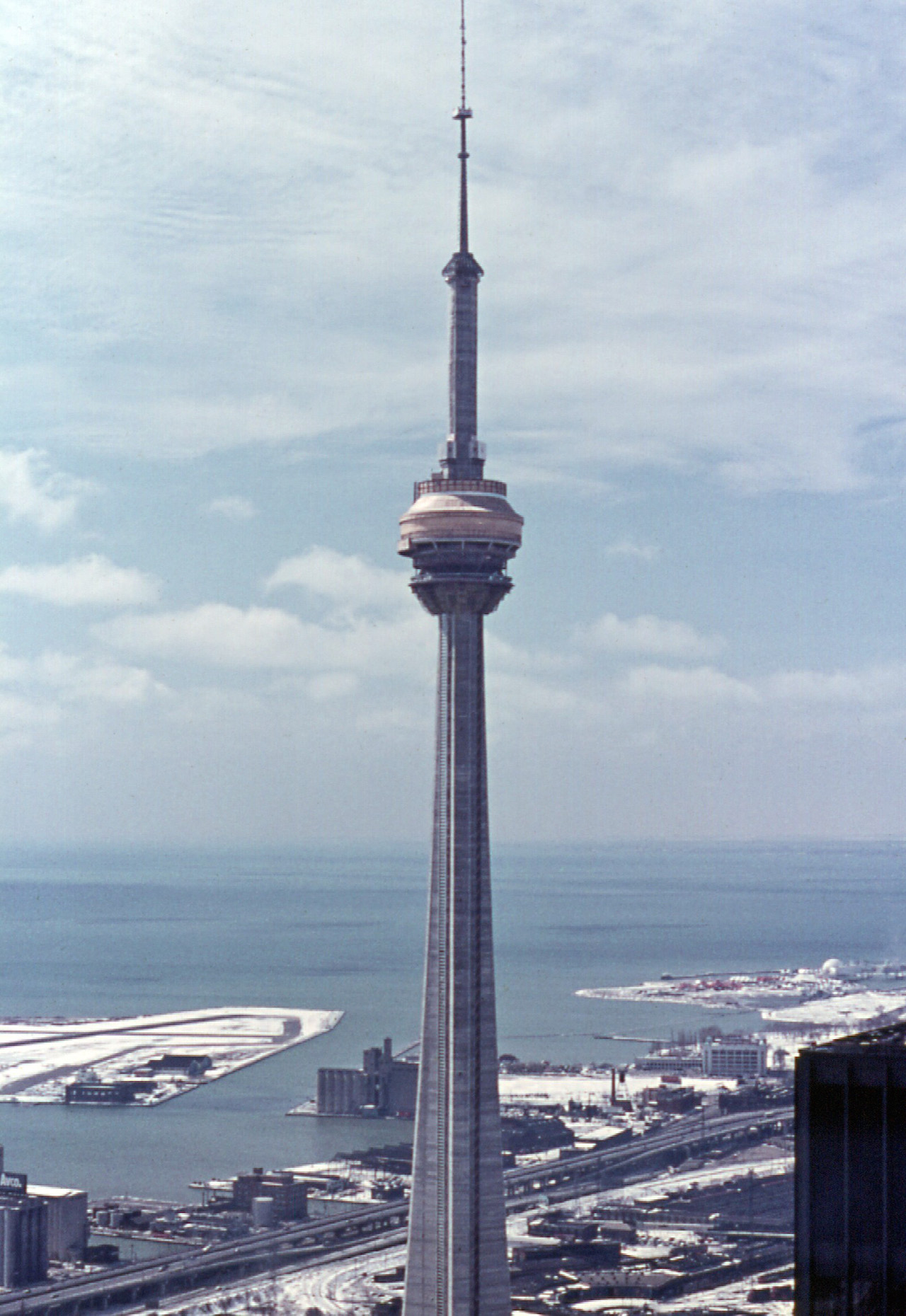 Construction of the CN Tower in 1975, image by Flickr user Robert Taylor via Creative Commons
Construction of the CN Tower in 1975, image by Flickr user Robert Taylor via Creative Commons
The CN Tower opened up new opportunities around the world for those involved in the project, especially WZMH, who has taken on major international commissions overseas. "The fact we had the talent here to deal with it just shows where Toronto and Canada was going at that time," said Quinn, who praised the CN Tower as fostering a new chapter of architectural and structural design. Quinn also recalls the "immense pride" felt by Torontonians upon its opening, who could now boast that their city was home to a record-breaking work of art.
For better or for worse, the CN Tower has adapted to modern times. Universal Man, a 6.5-metre bronze figure by Toronto-born sculptor Gerald Gladstone, was unceremoniously dumped into vacant railway lands near the Gardiner Expressway and Spadina Avenue to make room for the SkyDome. Though the sculpture has since been moved just outside Yorkdale Shopping Centre, the original location suggested deeper meaning. Its prominent position at the base of the tower was intended to humanize the imposing concrete structure—which many believed had a phallic symbolism—by bringing it back to the earth.
 Universal Man outside Yorkdale Shopping Centre, image by Simon P via Wikimedia Commons
Universal Man outside Yorkdale Shopping Centre, image by Simon P via Wikimedia Commons
Other less controversial changes have been made in the four decades since the CN Tower's opening. The north-facing stairwell has since been relocated to the core, making way for glass elevator corridors on all three sides of the structure. For a vertigo-inducing experience right off the bat, elevators were equipped with glass floors beginning in 2008. The incandescent lights that limited the CN Tower to a fixed night lighting scheme have been substituted with a modern LED system. This has allowed the tower to mark celebrations, holidays and major events with unique colour combinations. The popular EdgeWalk, which guides courageous guests around the roof of the main pod at 356 metres, opened in 2011. A recent revitalization of the welcome area and plaza, along with periodic re-patching of the concrete, are some of the aesthetic adjustments that have kept the tower's appeal and appearance fresh.
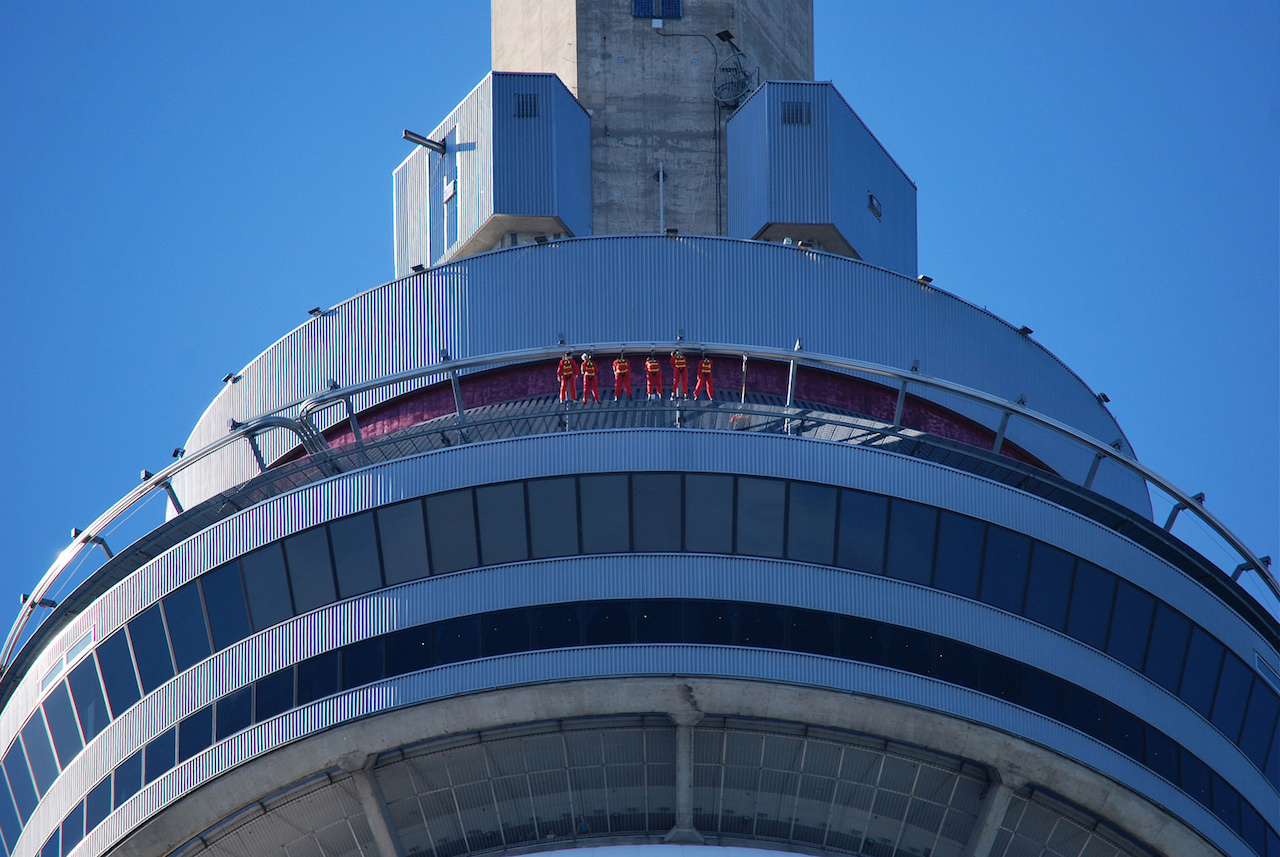 Guests brave the EdgeWalk, image by Marcus Mitanis
Guests brave the EdgeWalk, image by Marcus Mitanis
Though the CN Tower's height was overtaken by the Burj Khalifa in 2007, and a number of other Asian towers in the years following, its impact on the Toronto cityscape has not subsided. The upcoming throng of supertall proposals seek to add balance to the skyline, but none have sought to soar higher than the CN Tower. The 686-metre Maryon Tower proposed for College Park in the 1970's would have, but it never materialized. The ambition and drive to break records has seemingly moved elsewhere, to the Dubai's of the world, where developers are eager to make a statement despite questions over the purpose and value of such ventures. Carl Blanchaer, Senior Principal at WZMH and member of the City of Toronto's Design Review Panel, notes that the composition of the development industry has changed. He states that many developers are linked to pension funds and as a result, have an obligation to look after this money. It's a more conservative and cautious approach to city building that has changed the spirit of the development community, making the iconic and groundbreaking projects proposed in decades past less likely in the current climate.
 View from the outdoor observation deck, image by Marcus Mitanis
View from the outdoor observation deck, image by Marcus Mitanis
Despite this, the market has begun showing an appetite for supertall structures. While the land value today isn't great enough to support the super-slim residential-only towers proposed in Manhattan, Blanchaer believes there is proven demand for mixed-use supertalls with significant residential components. Projects like The One, Mirvish+Gehry, and 1 - 7 Yonge are responding to the demand for density and efficient use of land. "People are comfortable with tall buildings but there's a sense that they should only happen in certain areas of the city," said Blanchaer. "There's a sensitivity to scale and animation at street level and having a pedestrian-friendly city." The issue with the latest crop of building proposals, one that perhaps was not traditionally a major consideration when the core was expanding, "will be their appropriate placement so they don't destroy the urban fabric." Supertalls like the CN Tower and Burj Khalifa, isolated from their surroundings at the time of construction, were forging their own urban fabric. But as Toronto's core expands and available plots of land diminish, new developments need to respond to the neighbourhood context.
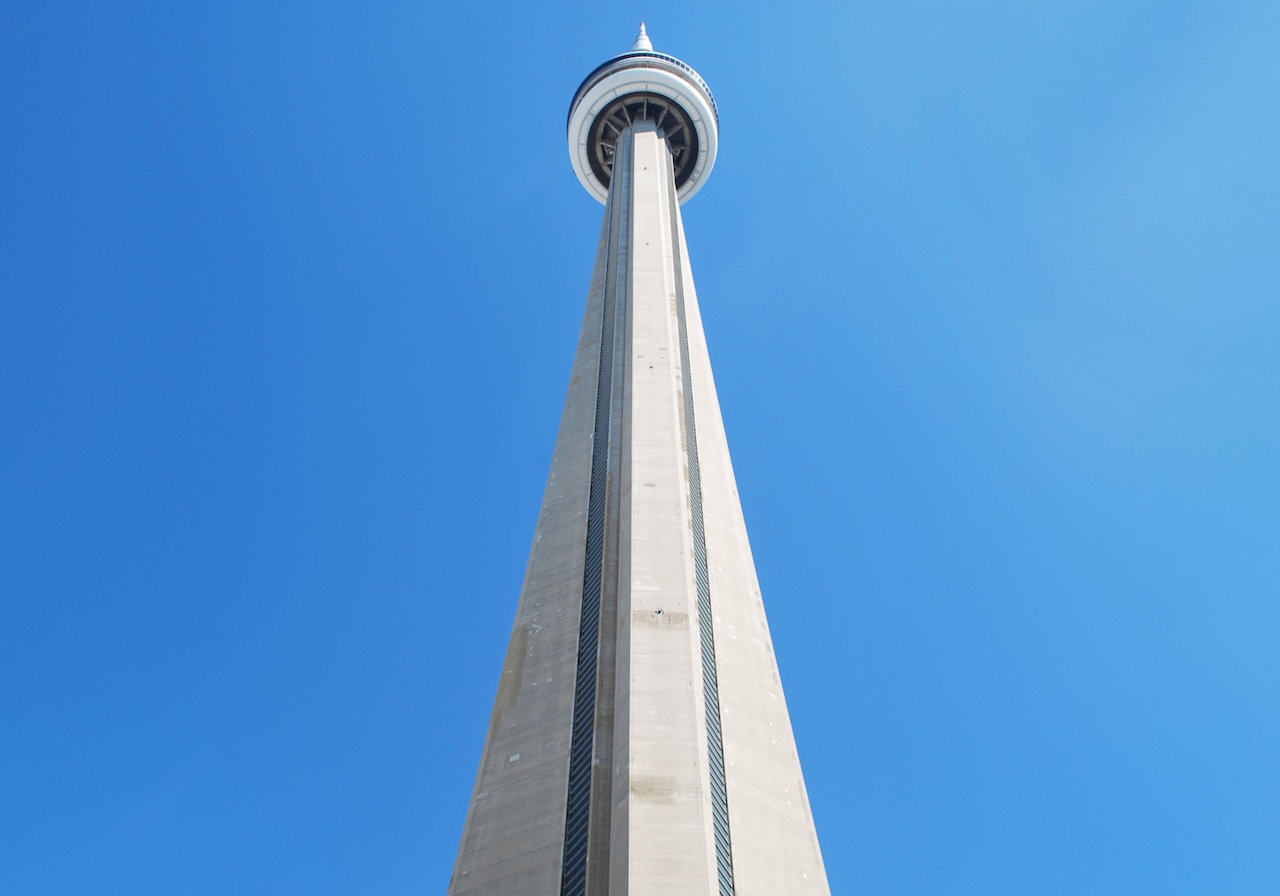 The classic ground level view of the CN Tower, image by Marcus Mitanis
The classic ground level view of the CN Tower, image by Marcus Mitanis
It's not the tallest freestanding structure in the world anymore, but that hardly matters. The CN Tower's contribution to city building, civic pride, and Canadian ingenuity will be timeless, much like the design of the structure itself. A perennial draw for tourists, with some two million international visitors taking in the views every year, the American Society of Civil Engineers recognized the CN Tower as one of the Seven Wonders of the Modern World in 1995. While Quinn can envision a future where the tower is dismantled and replaced by new uses, there's still plenty of room for the tower to continue its natural evolution. The visionaries and workers who made the CN Tower possible reinvigorated pride in the entrepreneurship of Canadians, launching careers and racking up accolades from around the world. The last 40 years have been kind to the CN Tower. Here's to the next 40!

 9.6K
9.6K 












